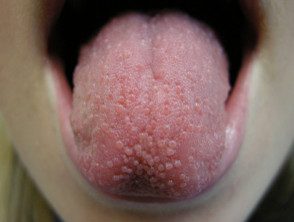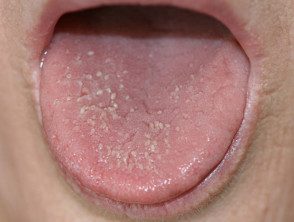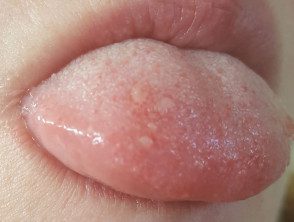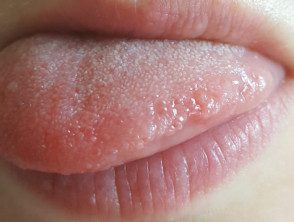What is transient tongue papillitis?
Eruptive tongue papillitis
Transient lingual papillitis
Transient lingual papillitis
Papulokeratotic variant
What are fungiform papillae?
Fungiform papillae are one of the special types of bumps found on the surface of the tongue. Mushroom papillae contain taste buds (especially for bitter taste), temperature receptors, and have a good blood supply.
They are found scattered over the top and sides of the tongue, mainly towards the tip. They are usually not obvious, they are flat and pink.
The number and size of the fungiform papillae varies:
- females have more fungiform papillae than males
- become even more numerous after menopause
- nerve injury can result in reduced number of fungiform papillae and reduced taste sensation
Mushroom papillae can become evident in a number of conditions, the most recognized of which is the scarlet "strawberry tongue" fever.
Who Gets Transient Tongue Papillitis and Why?
The classic form of transient lingual papillitis affects more than 50% of the population. It seems to be more common in young women, but all age groups can be affected. The most likely cause of transient tongue papillitis is local irritation or trauma to a fungiform papilla. However, many other possible triggers have been suggested, including stress, hormonal fluctuations, gastrointestinal upset, and specific foods.
Eruptive (familial) tongue papillitis affects young children and their families. It appears to be more common in spring, although it can occur throughout the year. Children in contact with many other children, such as school, kindergarten, or daycare, seem to be more likely to develop this condition. A viral cause has been suggested due to the common development of the condition in family members. One theory is that, similar to the herpes simplex / cold sore virus, the virus is caught in infancy and can cause recurrent Episodes throughout life, in this case presenting in adulthood as the classic form of transient lingual papillitis.
Papillary fungiform glossitis has been described in patients with a history of eczema, asthma or hay fever. It may be another name for transient tongue papillitis. These authors suggested that the condition is due to increased environmental sensitivity of the tongue, similar to increased sensitivity of the skin, lungs, or nose, resulting in eczema, asthma, or hay fever, respectively.
Clinical characteristics of transient lingual papillitis.
Classic shape
The classic form of transient lingual papillitis presents as a single painful red or white bump on the tongue, usually towards the tip. It lasts 1-2 days and then goes away, often recurring weeks, months, or years later. There is no associated disease or enlargement of the lymphatic gland. Less commonly, the lesions are more numerous, may disappear within hours or last for several days, or may be associated with a burning or tingling sensation. Infrequent injury(s) cannot cause any symptoms. Some reports suggest an association with geographic tongue or scalloped markings on the side of the tongue.
Papulokeratotic variant
The papulokeratotic variant presents as multiple recurrent white lumps on the tongue that do not cause any symptoms. They can be persistent.
Eruptive tongue papillitis
Eruptive tongue papillitis is a systemic illness often associated with fever and enlarged lymph gland. The onset is sudden. An affected child may be reluctant to eat and produces excessive saliva. The tongue shows enlarged, inflamed fungiform papillae at the tip and sides of the tip, but not the top. These may seem pustules. Angular cheilitis can be seen.
The disease lasts on average 1 week (range 2-15 days). Recurrences 1-2 months later with the same clinical characteristics have been reported. Family members, parents and siblings, may develop symptoms on average one week later (range 1-15 days). In adults, the disease presents as a sudden, severe burning of the tongue that is worsened by food. The clinical appearance is the same as in the child.
Eruptive tongue papillitis
Eruptive tongue papillitis
Eruptive tongue papillitis
How is transient tongue papillitis diagnosed?
Transient lingual papillitis and eruptive tongue papillitis are usually diagnosed clinically based on the typical presentation.
Mucous membrane biopsy shows inflammation and swelling of a fungiform papilla, but usually not necessary. The special stains do not detect viruses, fungi or bacterial infection. In the papulokeratotic variant, the biopsy shows severe and mild hyperpakeratosis. chronic inflammation.
¿Qué problemas puede traer la papilitis lingual transitoria?
Los síntomas incluyen dolor, sensación de quemazón y dificultad para masticar y hablar. La afección suele ser temporal y puede desaparecer sin tratamiento en unos pocos días a unas pocas semanas. Sin embargo, puede ser incómoda y puede interferir en la capacidad de una persona para comer y hablar.
La causa exacta de la papilitis lingual transitoria no se conoce, pero se cree que puede estar relacionada con factores como el estrés, la falta de vitaminas y minerales, una infección oral o una reacción alérgica a ciertos alimentos o medicamentos.
En general, el tratamiento de la papilitis lingual transitoria consiste en aliviar los síntomas y tratar la causa subyacente. El uso de analgésicos tópicos, como la lidocaína, puede ayudar a aliviar el dolor. Se recomienda también evitar alimentos y bebidas calientes o picantes y seguir una dieta rica en vitaminas y minerales, especialmente vitamina B y zinc. En caso de infección se recomienda tratamiento con antibióticos.
Es importante consultar con un médico si los síntomas persisten o empeoran, ya que pueden ser indicativos de una afección subyacente más grave.
En resumen la papilitis lingual transitoria es una afección inflamatoria temporal de la lengua que puede ser incómoda y afectar la capacidad de una persona para comer y hablar. El tratamiento se enfoca en aliviar los síntomas y tratar la causa subyacente.
Treatment of transient lingual papillitis.
Treatment is usually not required for the classic form of transient tongue papillitis, as the condition resolves within hours or days.
Treatments reported by some patients to give relief have included:
- salt water mouthwashes
- cold fluids
- relaxing foods like yogurt
- antiseptic or local anesthetic mouthwash
- current steroids
However, most patients have found nothing to relieve symptoms or prevent reappearance.
In eruptive tongue papillitis, acetaminophen, ibuprofen, and topical antiseptics have not been found to alter the duration or severity of symptoms in children.






